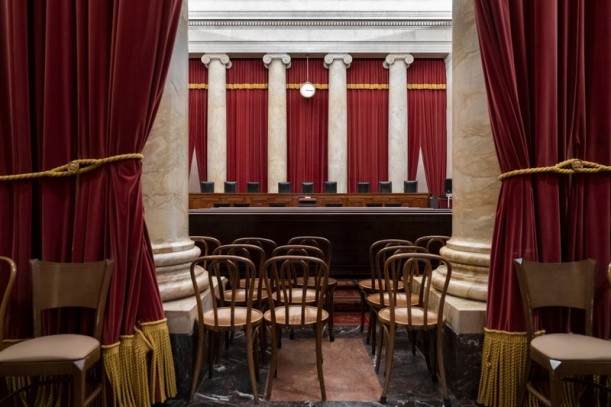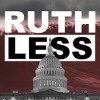Who Made the Drapes? It’s Among High Court’s Mysteries

The empty courtroom is seen at the U.S. Supreme Court in Washington on June 25, 2019. The mystery of the Supreme Court begins with the heavy red drapes that frame the courtroom on all sides, which sets the court apart from other federal courts. (AP)
Washington – The lack of transparency at the U.S. Supreme Court begins with the heavy red drapes that frame the courtroom on all sides. The court replaced the drapes this summer but would not reveal the name of the company that did the work.
The court’s role in a bitterly divided Washington and nation may be more important than ever, yet basic details about how the court operates remain obscured. The court is not subject to the federal Freedom of Information Act and the justices are not bound by most ethics rules that apply to all other federal judges.
Its arguments aren’t televised. The justices decide for themselves how much to tell the public about travel plans, speaking engagements or health issues. They typically don’t disclose their reasoning when they decide to sit out cases that may pose conflicts of interest. And beyond the secrecy surrounding the drapes are other questions about the building, including which groups are allowed to use the taxpayer-funded structure for after-hours parties.
These developments have led to a raft of reform proposals, many with scant chance of success. There are calls for the justices to adopt an ethics code, enhance disclosure of travel and other gifts and allow broader access to court proceedings.
“We’re at a moment when trust in American institutions is declining across the board and the court itself has taken a hit in that trust,” said Alicia Bannon, managing director of the democracy program at New York University’s Brennan Center. “It’s important for the court to be a leader on ethics.”
She is co-author of a report advocating for a Supreme Court code of ethics, explanations of decisions to sit out cases and enhanced travel and gift disclosures.
The justices have generally opposed the changes. Several have said over the years that the court is the most transparent branch of government because their written opinions explain the decisions they have reached and why, while dissents often point out in exacting detail where one side believes the other has gone wrong.
The majestic building at the top of Capitol Hill is first and foremost a public office building, open to the public on weekdays. But it also serves as a coveted, after-hours event space, used 30 to 50 times a year by private groups, if they are sponsored by a justice.
One of those groups is the conservative Federalist Society, which held a reception in July 2018 that was attended by Justice Samuel Alito. The group posted photos from the event on its Facebook page.
The court would not provide a comprehensive list of groups, events or sponsoring justices.
“The court does not maintain public records of organizations holding events,” spokeswoman Kathy Arberg said.
But groups that use the building typically have a connection to the court or the law, and they pay up to $6,000 for an event, Arberg said.
The nine justices are in high demand as speakers around the country because they issue momentous rulings that touch all corners of American society. But they decide when to provide advance word of their speaking engagements and sometimes let sponsoring organizations close their talks to news coverage.
Justice Brett Kavanaugh’s recent Federalist Society speech was open to reporters, but Kavanaugh did not allow video cameras at his talk to more than 2,000 people at Washington’s Union Station.
The choice also is left to each justice when it comes to stepping aside from pending court cases. Recusals rarely come with explanations. The public is left to piece together the reason from the justices’ yearly financial disclosures, work histories and sometimes, family trees.
When health issues arise, each justice decides what to tell the public and when.
Justice Ruth Bader Ginsburg has provided ample details of her many medical issues, but the court waited until the 86-year-old’s summer radiation treatment had ended before announcing she had a tumor on her pancreas. Recently, she was taken to a Washington hospital with fever and chills on a Friday, but the court didn’t say anything for 24 hours.
But that was far quicker than with news about then-Justice Anthony Kennedy’s heart procedure. The court waited 10 months to reveal that doctors had inserted a stent in one of Kennedy’s arteries, saying something only when the stent had to be replaced in 2006.
The justices’ annual reports list who pays for their travel but does not include the cost of transportation, hotels and meals. Legislation from Sen. Sheldon Whitehouse, D-R.I., a frequent court critic, and Rep. David Cicilline, D-R.I., would require the justices and all federal judges to fill in those details within 15 days after they return home.
“To avoid conflicts of interest, the American people ought to know what hospitality, travel, and other emoluments justices and judges receive,” Whitehouse said.
Similar past efforts aimed at court transparency, including proposals to have court proceedings televised, have languished in congressional committees.
The federal judiciary says it does not post judges’ financial reports online for security reasons, though media and interest organizations often do.
In July, Ginsburg and Justice Sonia Sotomayor traveled to Portugal for a New York University conference. There was no advance word of the trip, which the justices presumably will include on their 2019 financial reports that won’t be made public until June 2020.
The public knows about the travel now only because Ginsburg talked about it in her eulogy for the late Justice John Paul Stevens, who died at age 99 less than a week after returning from the same trip.
When the court hears cases, the courtroom is open to the public, only a couple hundred people are lucky enough to be admitted on any given day. The justices refuse to allow the broader public to watch arguments or even listen to them as they happen.
Chief Justice John Roberts has so far this term denied requests to provide streaming or same-day audio for two of the biggest cases, about protections for LGBT people from workplace discrimination and immigrants brought to the U.S. as children. Audio recordings are made available a few days after the arguments.
By contrast, the federal appeals court that meets in the courthouse less than one-half mile from the Supreme Court livestreams the audio of all its arguments. The 9th U.S. Circuit Court of Appeals in San Francisco regularly provides live video of its arguments. Internationally, when Britain’s highest court ruled in September that Prime Minister Boris Johnson’s shuttering of Parliament was illegal, the decision was read live on camera by U.K. Supreme Court President Brenda Hale.
“The Supreme Court should be leading the judiciary in openness and accountability, but by and large, it’s fallen behind,” said Gabe Roth, executive director of the watchdog group Fix the Court.
User login
Omaha Daily Record
The Daily Record
222 South 72nd Street, Suite 302
Omaha, Nebraska
68114
United States
Tele (402) 345-1303
Fax (402) 345-2351




